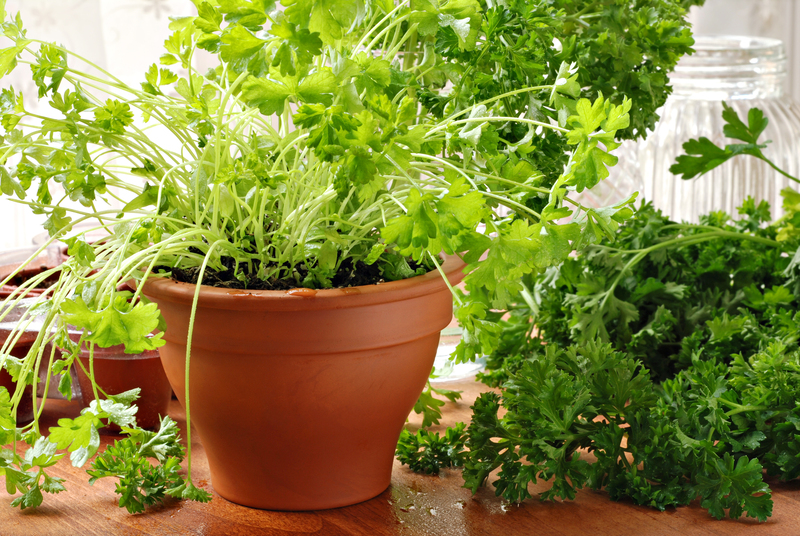Creating a Robust Garden to Withstand Severe Weather
Posted on 01/06/2025
Creating a Robust Garden to Withstand Severe Weather
In today's world of increasingly unpredictable weather patterns, cultivating a garden that can endure harsh conditions is more important than ever. From torrential rains to blistering heat waves, garden resilience is a necessity for both novice and experienced gardeners. In this comprehensive guide, we'll explore strategies for creating a weather-proof garden, discussing plant choices, soil preparation, protective structures, and ongoing maintenance tips to help your garden thrive, no matter what Mother Nature throws your way.

Understanding the Need for a Weather-Resilient Garden
The climate is changing, and so are the challenges facing today's gardeners. From unexpected frosts to sudden droughts, severe weather can quickly undo months of hard work. Creating a robust garden to withstand severe weather means planning ahead, selecting the right varieties, and building in layers of protection that can safeguard your plants and soil in the toughest conditions.
Why Garden Resilience Matters
- Protection of Investment: Time, effort, and money go into every garden. Severe weather can cause significant losses if gardens are not designed for resilience.
- Food Security: For those who rely on their gardens for food, extreme weather events can mean reduced harvests unless proper protective measures are taken.
- Biodiversity & Ecosystem Services: A well-planned, robust garden supports pollinators, beneficial insects, and native wildlife even in adverse conditions.
Designing Your Garden for Maximum Weather Resistance
The foundation of any weather-resistant garden lies in thoughtful design. By understanding your region's typical weather hazards and employing smart landscaping techniques, you can dramatically improve your garden's ability to bounce back after storms or temperature extremes.
1. Site Selection & Layout
- Assess Microclimates: Study your yard for areas that receive more sun, are prone to frost pooling, or have windbreaks such as fences or trees.
- Opt for Raised Beds: Raised beds provide excellent drainage during heavy rain events and warm up faster in cool periods.
- Utilize Natural Windbreaks: Position taller plants, shrubs, or fences strategically to shield vulnerable garden areas from prevailing winds.
2. Enhance the Soil for Resilience
The strength of your garden in severe weather starts with the soil. Healthy, well-structured soil improves drainage during storms and retains moisture during droughts.
- Regular Composting: Adding compost improves soil structure and nutrient content, increasing both water retention and drainage.
- Mulching: Apply organic mulch to insulate roots from temperature extremes, suppress weeds, and conserve soil moisture.
- Soil Testing: Test soil annually to ensure a balanced pH and nutrient levels, which empowers plants to better withstand stresses.
3. Choosing Weather-Tolerant Plants
Selecting varieties that are naturally suited to your climate or bred for hardiness is crucial for creating a garden capable of enduring severe weather. Here's how to make wise plant choices:
- Native Species: Native plants are already adapted to local weather extremes and generally need less care during droughts and storms.
- Drought-tolerant Varieties: Look for plants labeled as "drought-resistant" or "xeric" for regions prone to dry spells.
- Flood-Tolerant Plants: In low-lying or flood-prone areas, choose varieties that can survive periodic waterlogging.
- Wind-resistant Shrubs & Trees: Compact, flexible plants are less likely to suffer storm damage.
- Disease-resistant Cultivars: Varieties that resist local diseases will cope better under stress.
4. Diversify Your Plantings
A diverse garden is less likely to be wiped out by a single weather event. Mixing annuals, perennials, trees, and shrubs of varying sizes and lifecycles maximizes resilience.
- Polyculture Beds: Growing different types of plants together mimics natural ecosystems and boosts overall durability.
- Staggered Planting Times: Plant successive rows or patches to spread out the risk of loss from a single severe event.
Protecting Your Garden from Extreme Conditions
Despite your best preventive efforts, severe weather can still strike. The following in-season practices will help limit damage and ensure a fast recovery.
1. Preparing for Drought
- Deep Watering: Water less frequently but more deeply to encourage plants to develop deep, drought-resistant root systems.
- Install Drip Irrigation: Drip systems deliver water directly to plant roots, minimizing evaporation and maximizing efficiency.
- Shade Structures: Use temporary shade cloth or plant tall companions to shield sensitive plants during heatwaves.
- Mulch Generously: A thick mulch layer prevents evaporation and regulates soil temperature.
2. Managing Heavy Rains & Flooding
- Improve Drainage: Raised beds, French drains, or swales can direct excess water away from plants.
- Avoid Soil Compaction: Do not walk on saturated soil, as compaction reduces aeration and makes future flooding worse.
- Secure Young Plants: Stake vulnerable seedlings or use protective collars to keep them upright in storms.
- Emergency Covers: Keep row covers or plastic sheeting handy to shield beds during major downpours.
3. Buffering Against Wind and Storms
- Permanent Windbreaks: Plant dense hedges or erect fences along the windward side of the garden.
- Strategic Pruning: Regularly prune trees and shrubs to remove dead or weak limbs that could break in high winds.
- Use Sturdy Supports: Use cages, stakes, or trellises to support tall and top-heavy plants.
- Plant in Groups: Cluster plants together for mutual protection against the wind.
4. Defending Against Frost and Cold Snaps
- Row Covers and Cloches: Use lightweight fabric row covers or cloches to keep frost off tender plants.
- Water Before Frost: Well-hydrated plants handle cold better; water your garden before frost is expected.
- Mulch Insulation: Mulch can insulate roots from sudden freezes.
- Utilize Microclimates: Plant frost-sensitive species near south-facing walls or under overhangs for extra warmth.
Long-Term Strategies for a Weatherproof Garden
Resilience isn't just about weathering the next storm--it's about building strength and adaptability into your garden for the years ahead. Here's how to reinforce your garden foundation year after year to better withstand strong weather.
Plan for Change
- Ongoing Observation: Keep detailed garden journals and note patterns of weather and plant health.
- Adaptive Management: Be willing to adjust your strategies based on experience and changing climate trends.
- Seasonal Soil Amendments: Replenish mulch and organic matter every season to maintain fertile, sponge-like soil.
Community & Support Networks
- Local Gardening Clubs: Share knowledge and resources to stay on top of the latest resilience strategies.
- Cooperative Efforts: Share or trade seeds and cuttings of proven tough varieties with neighbors.
Invest in Proper Tools and Resources
- Emergency Kits: Keep row covers, stakes, extra mulch, and water reservoirs on hand.
- Weather Monitoring: Invest in a home weather station or reliable app to anticipate extreme conditions before they strike.
The Role of Technology in Creating a Robust Garden
Modern technology offers invaluable support in creating a weather-resistant garden:
- Automatic Irrigation: Smart watering systems monitor soil moisture and adjust watering schedules for optimal drought protection.
- Weather Apps & Alerts: Get real-time weather updates to know when to batten down the hatches or water your beds.
- Plant Databases: Access recommendations for robust plants suited to your exact local conditions.
Recovering Quickly After Severe Weather Events
Even with the strongest preparations, damage can occur. Knowing how to respond quickly is critical for a fast recovery. Here's your post-storm action plan:
- Inspect and Triage: Walk through the garden, prioritize repairs, and remove broken branches or damaged plants.
- Aerate and Mulch: After heavy rain, gently aerate compacted soil and reapply mulch to stabilize beds.
- Replant as Needed: Replace annuals or vegetables lost to frost or floods with quick-growing crops.
- Monitor for Pests & Disease: Stressed plants are vulnerable--begin integrated pest management immediately.

Top-Rated Plant Choices for Weatherproof Gardens
Selecting the right plants is central to creating a robust garden that can withstand severe weather. Here are popular options respected for their resilience:
Drought-Resistant Choices
- Lavender: Tolerates dry, poor soils and hot sun.
- Sedum: Succulent groundcover that needs little water.
- Russian Sage: Hardy and heat-tolerant, ideal for exposed borders.
Flood-Tolerant Plants
- Swamp Milkweed (Asclepias incarnata): Thrives in consistently moist soils.
- Iris: Many varieties tolerate heavy soil and brief inundation.
- Buttonbush: Shrub for areas prone to spring flooding.
Wind-Resistant Selections
- Panicum (Switchgrass): Upright yet flexible ornamental grass.
- Holly or Boxwood: Dense, compact shrubs for windbreaks.
- Crabapple Trees: Low, well-anchored branches handle storm winds.
Frost-Hardy Vegetables
- Kale: Thrives in cold and even improves in flavor after frost.
- Spinach: Tolerates freezing temperatures and keeps producing.
- Carrots: Can remain in the ground through snow with mulch.
Conclusion: Future-Proof Your Garden
Weather extremes are a fact of modern gardening. By embracing resilient design, selecting the right plants, and staying prepared with the proper resources and knowledge, you can create a truly robust garden that withstands severe weather year after year. A resilient, weather-proof garden is not only a source of pride--but also provides beauty, food, and habitat in every season, no matter what challenges come your way.
Start today: assess your current garden, make a plan, and transform your outdoor space into a model of sustainability and strength. With careful stewardship, your garden will not just survive--but flourish--under any sky.

